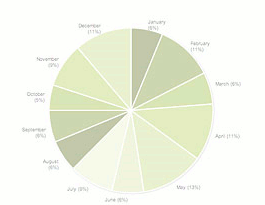


Convenient Summary about Women in NAS
Dear friends of women in science,
Some time ago I received a helpful email from Anne B. Sereno pointing out a web site for "IAP--the Global Netweork of Science Academies." It has a page on the US National Academy of Science on which information about total membership and membership by women is given. We've shown a plot before of women and men elected by year, but this site appears to give totals, which NAS emailed me to say they do not release per se, although one can obtain a list of the total membership.
According to this site (see it here), there are 2100 members and 300 foreign associates. There are 216 women members and 32 women foreign associates. It is a bit disconcerting that the first two numbers are given twice on the site and there are small variations in the numbers given for total and foreign members. Assuming these numbers are a reasonable approximation of reality, although I am not sure of the date of this posting, should we worry about these numbers? Do you think only 10% of the outstanding scientists in the US, and foreign associates, are women?
cheers,
Laura

Hi Alice,
Yes, I posted one of your AWIS graphs last year. But as far as I know, AWIS hasn't given the total percent women for the NAS. The trend analysis is very informative though, and I highly recommend that everyone go to the URL you gave and look over the data. The predicted versus elected graphs are very telling.
thanks!
Laura
Hi Laura,
The Association for Women in Science (AWIS) has been tracking NAS elections for years, and we have comprehensive data on this topic. Check out our webpage for the representation of women among members of the National Academies: http://awis.org/displaycommon.cfm?an=1&subarticlenbr=448.
The first graph shows the overall proportion of men vs. women by election year, from 1994 to 2011. There was a spike of both men and women in 2002, because the NAS increased its number of elected members from 60 to 72. This was in response to a number of complaints that there were not enough women; instead of increasing the proportion of women elected, they simply increased the total number and the proportion stayed relatively the same. In subsequent years, however, the number of women went back down to previous levels (just 9 out of 72 were women last year) while the number of men stayed elevated.
We also break down the proportion of men vs. women in each of the separate Academies, and in the final graph we compare the number of men and women NAS members to the expected availability pools of men and women senior researchers in science, based on NSF data for PhDs awarded 20 years ago.
Between 2003 and 2005, the number of women NAS members surpassed the number of expected women, but since then the number of available women has been increasing (more women entering STEM fields) while the number of women elected to NAS remains near average lows.
Hi Laura,
I agree the real number should be higher, but given that they only choose outstanding senior faculty and given the low number of senior women faculty at top tier research institutions, I doubt you could get that number higher right now.
In fact any changes that have improved the number of senior women at those institutions wouldn't be seen in this forum for another 5-10 years.
If there was real change to attract and retain women in academic positions perhaps we would see this grow in the future.
Helen
Dear Laura,
It's shaky since the data do contradict themselves a bit, but I guess they are similar numbers. I never heard of this organization, but assuming it's real and has some approximation of the truth, the numbers are too low. We've been suspecting that. But there's no direct way to increase the numbers given the secrecy of the elections.
Hi Laura,
I think there were almost none for years, and now it's increasing. But that said, it's not increasing nearly fast enough, and there is, I've heard, resistance to trying to find women to consider. Of course, the whole process is secret so we don't really know.

















